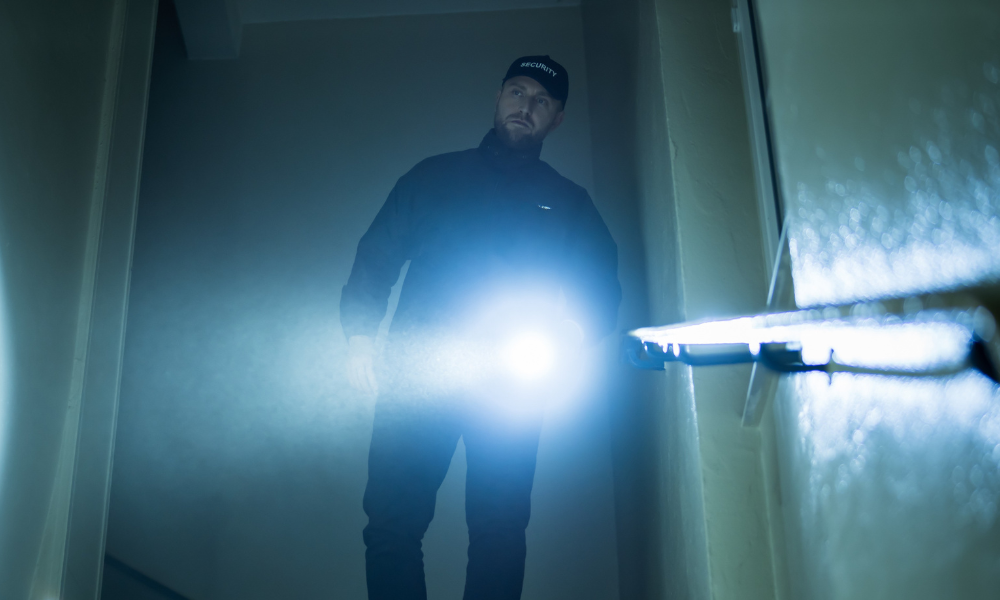
Night guards are present in many sectors, including security, healthcare, hospitality, and industry. These professionals ensure the protection of property and people and often face isolated working conditions.
Working alone at night exposes these employees to specific risks, requiring appropriate preventive measures. Indeed, these workers are not only alone while performing their tasks, but they also work staggered hours.
Given this risky work situation, employers must implement the necessary devices and protocols to ensure the safety of night watchmen. These workers may experience health problems or face incidents or assaults during their work hours. To mitigate the risks and dangers related to their isolation, it is essential to establish appropriate measures.
This article offers an in-depth analysis of the challenges of isolated work for night security guards, the dangers they face, and the solutions to ensure their protection.
Who are night guards and why do they work alone?
Night guards work in various sectors:
- Private security: security guards, custodians of industrial or commercial sites.
- Hospitality and tourism: night receptionists, concierges.
- Health and social care: supervisory staff in hospitals, nursing homes, care centers.
- Transport and logistics: parking attendants, depot or warehouse supervisors.
Their work often involves long hours of isolated work, sometimes in sparsely frequented locations, which increases their vulnerability in case of incidents. Working alone in this case is even more pronounced since they work staggered hours.
Specific risks for night watchmen working alone
Security risks for night guards
Night watchmen are particularly exposed to risks of assaults and malicious acts:
- Attempts of intrusion or theft on the sites they monitor.
- Physical or verbal assaults, especially in sensitive environments.
- Risks of confrontation with hostile individuals.
Medical risks when working alone at night
Working alone at night increases the risk in case of health issues:
- Cardiac arrest or stroke without immediate witnesses.
- Increased fatigue that can lead to mistakes or accidents.
- Sleep disorders related to night work.
Beyond increasing health risks, isolated work often delays the response time for medical assistance, which can be critical in many situations. For example, in the case of a stroke or heart attack, every minute counts for the worker’s health. Similarly, during accidents causing burns or hemorrhages, timely medical intervention can significantly affect the severity of the injury.
Psychosocial risks for night guards working alone
Professional isolation of night guards can lead to:
- Stress and anxiety due to the absence of colleagues.
- Mental and physical fatigue caused by irregular hours.
- Heightened feelings of insecurity due to solitude and the nighttime environment.
What solutions exist to secure night guards?
Safety monitoring devices for night guards
Safety monitoring devices are equipment that allow night guards to send alerts in case of trouble. These solutions include:
- Manual alert buttons: a simple press sends an emergency signal.
- Fall and inactivity detectors: send alerts if the worker remains immobile abnormally long.
- Real-time geolocation: essential for large sites or outdoor interventions (although reliability varies greatly depending on the model).
- Connected cameras and intercoms: enable remote monitoring and instant communication with a control center.
Improving working conditions for night guards
To address the risks linked to isolated work, several measures and protocols can be implemented:
- Patrolling in pairs: organizing rounds in duos when possible.
- Regular check-ins via radio or phone: setting up a system for clock-ins or periodic reports.
- Training in first aid and emergency management.
- Creating secure spaces: installing shelters or reinforced monitoring posts.
Conclusion on isolated work of night guards
Working alone at night poses significant risks, both in terms of physical safety and mental health. Faced with these challenges, it is essential for employers to implement suitable solutions, whether alert devices, specific training, or organizational adjustments.
